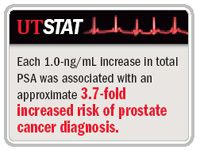Article
PSA at middle age indicates long-term prostate cancer risk
A single PSA value measured in men between 44 and 50 years of age is highly predictive of the development of clinically diagnosed prostate cancer up to 25 years later.

Key Points

The researchers also reported that men whose total PSA (tPSA) was 1.0 ng/mL and higher were at increased risk for developing prostate cancer by age 75 compared to the median risk of the general population. However, that increased risk was harbored by less than 20% of these men.
"The greatest importance of this research relates to its value for helping us to develop a solid biological base for developing new concepts on early prostate cancer detection strategies," said lead author Hans Lilja, MD, PhD, attending research clinical chemist, Memorial Sloan-Kettering Cancer Center, New York.
The study included men who participated in the Malmö Preventive Medicine (MPM) project, a longitudinal study in Sweden designed to investigate cardiovascular disease risk. It enrolled 21,277 men ages 33 to 50 years between 1974 and 1986, 90% of whom were ages 44 to 50 years.
Archived baseline anticoagulated plasma specimens were analyzed for four forms of PSA (total, free, complex, and percent free to total) and human kallikrein 2 (hK2) from 462 men who were subsequently diagnosed with prostate cancer (median delay, 18 years) and 1,222 matched controls. The prostate cancer cases were identified through the Swedish Cancer Registry database, and each was matched with three MPM participants on the basis of age and date of MPM baseline blood collection.
hK2 and all forms of PSA were found to be highly associated with prostate cancer risk. Analyses determining area under the curve (AUC) for discriminating between cancer and non-cancer showed that tPSA and complex PSA (cPSA) were equally informative (AUC ~0.76 for both) and that adding free PSA, percentage free PSA, and hK2 to tPSA did not improve discriminative accuracy in this setting.
Further analyses focused on tPSA and included calculation of cumulative risk of prostate cancer by age 75 with men stratified by tPSA level. Relative to the reference group of men whose PSA level was 0.00 to 0.50 ng/mL, the probability of later development of prostate cancer was found to increase sharply across the subgroups of increasingly elevated tPSA levels. Men with a tPSA >1.00 to 2.00 ng/mL had a seven-fold increased risk; the risk was approximately 20-fold higher in men with a PSA >2.00 to 3.00 ng/mL; and it was almost 40-fold higher in those with a PSA >3.00 ng/mL.
In those latter three tPSA subgroups, the cumulative risks of prostate cancer diagnosis by age 75 were 20%, 41%, and 60%, respectively, compared with only 4% in men with a tPSA value of 0.00 to 0.50 ng/mL.
"According to data from the Swedish Cancer Registry, the median cumulative risk for the general population in the year 2000 was 10.5% at age 75," Dr. Lilja said.
The relationships between tPSA and prostate cancer risk were maintained when the analysis was restricted to men with clinically palpable prostate cancer at diagnosis. Each 1.0-ng/mL increase in total PSA was associated with an approximate 3.7-fold increased risk of prostate cancer diagnosis in the overall population and in all subgroups when men were subdivided by years elapsed between blood collection and date of prostate cancer diagnosis.





